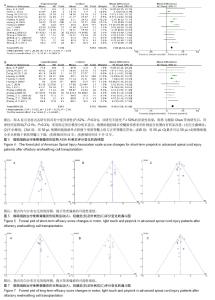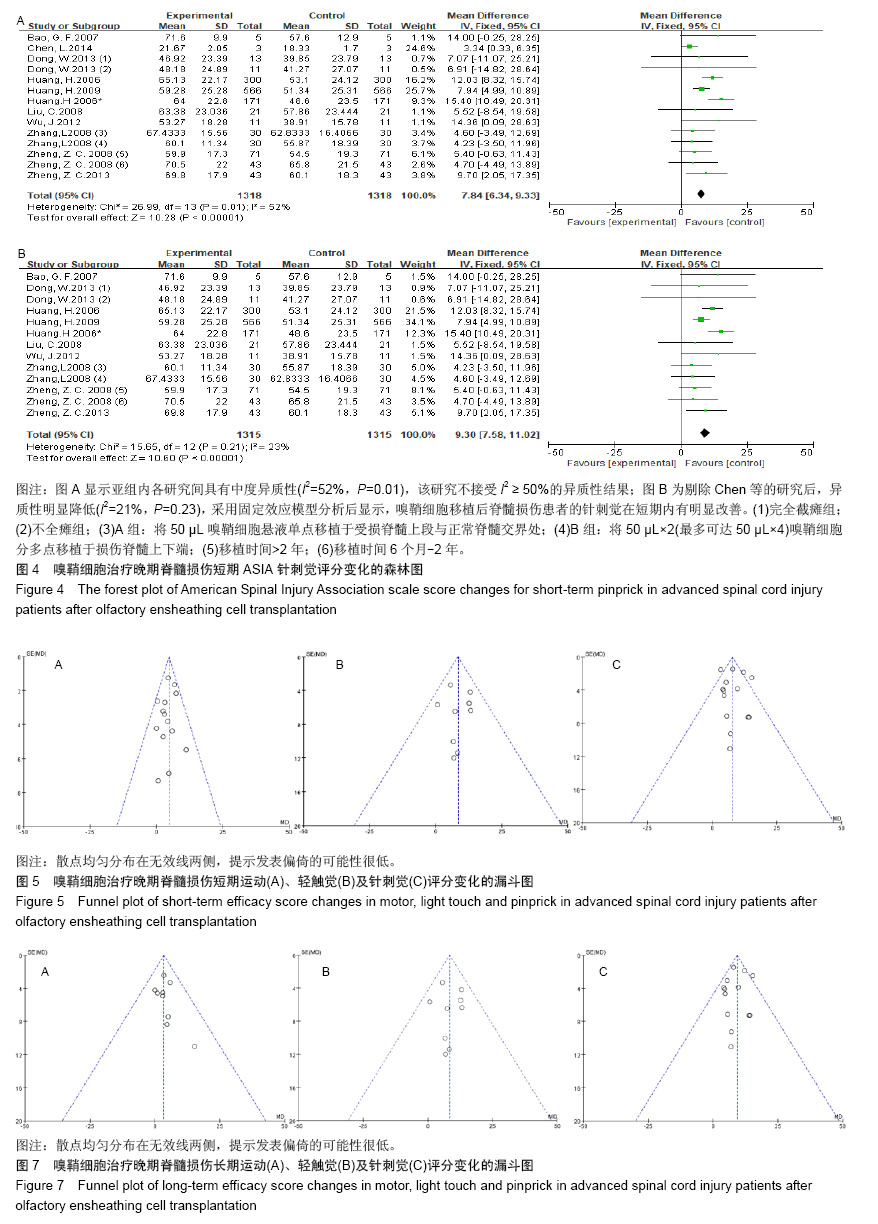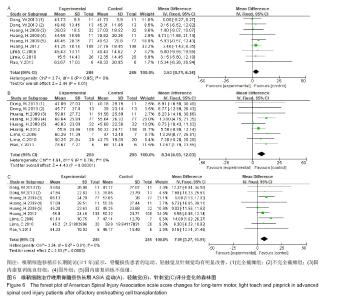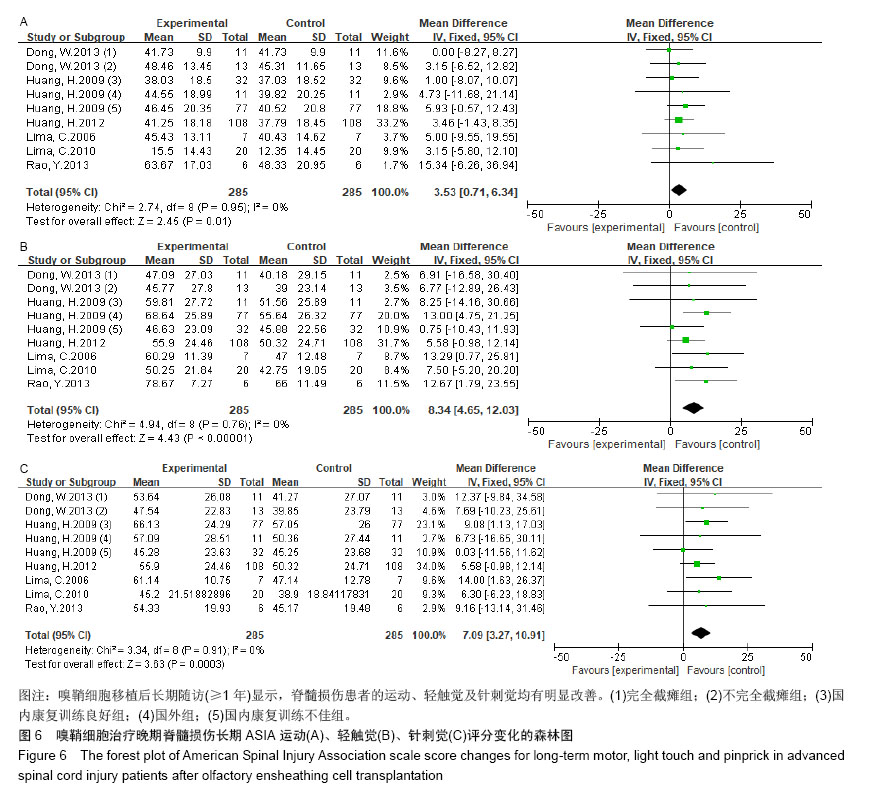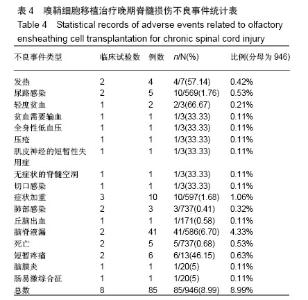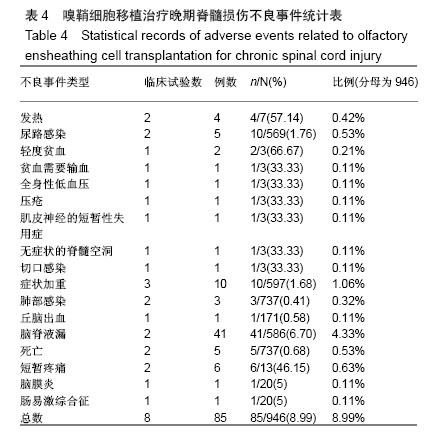Chinese Journal of Tissue Engineering Research ›› 2019, Vol. 23 ›› Issue (9): 1468-1476.doi: 10.3969/j.issn.2095-4344.1595
Short- and long-term effects of olfactory ensheathing cells in the treatment of chronic spinal cord injury: a meta-analysis
Chen Huijing1, Chen Yun1, Deng Yuer1, Gan Yanling1, Zhan Wengang2, Tan Qijia2, Xie Caijun2, Li Cong2, Zhang Zhiqiang2
- 1Second Clinical Medical College, Guangzhou University of Chinese Medicine, Guangzhou 510006, Guangdong Province, China; 2Guangzhou Hospital of Traditional Chinese Medicine (Second Affiliated Hospital of Guangzhou University of Chinese Medicine), Guangzhou 510120, Guangdong Province, China
-
Revised:2018-11-20Online:2019-03-28Published:2019-03-28 -
Contact:Zhang Zhiqiang, Guangzhou Hospital of Traditional Chinese Medicine (Second Affiliated Hospital of Guangzhou University of Chinese Medicine), Guangzhou 510120, Guangdong Province, China -
About author:Chen Huijing, Master candidate, Second Clinical Medical College, Guangzhou University of Chinese Medicine, Guangzhou 510006, Guangdong Province, China -
Supported by:the Guangdong Province Scientific Plan Project, No. 2014A020212411 (to ZZQ)
CLC Number:
Cite this article
Chen Huijing, Chen Yun, Deng Yuer, Gan Yanling, Zhan Wengang, Tan Qijia, Xie Caijun, Li Cong, Zhang Zhiqiang. Short- and long-term effects of olfactory ensheathing cells in the treatment of chronic spinal cord injury: a meta-analysis[J]. Chinese Journal of Tissue Engineering Research, 2019, 23(9): 1468-1476.
share this article
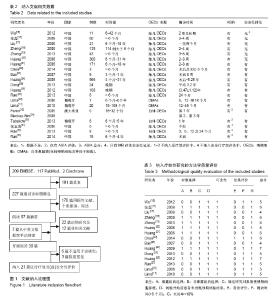
2.1 文献检索结果及纳入研究的基本特征 搜索PubMed,EMBASE和CochraneLibrary数据库,纳入328篇论文,排除重复文献、回顾性文献、个案报道、综述、动物实验及不相关文献304篇。另外,研究员手动搜索中英文数据库,纳入3篇英文文献及4篇中文文献。在仔细阅读文献中,研究员发现6篇疗效数据不适用于此次研究,3篇数据重复,详见图1。 此次研究选择了包含2 636例患者的11项研究进行短期疗效分析(术后2-8周)[15-25],选择了包含570例患者的6项研究进行长期疗效分析(术后1年以上)[11,24-28]。安全性分析方面,纳入15篇文献[10-11,21-33],即14个临床试验里面包含946例脊髓损伤患者。纳入文献的基本特征见表2。 2.2 纳入疗效性评价文献的质量评价 纳入15个疗效性评价文献,按改良后的NOS量表评价,具体结果见表3。"
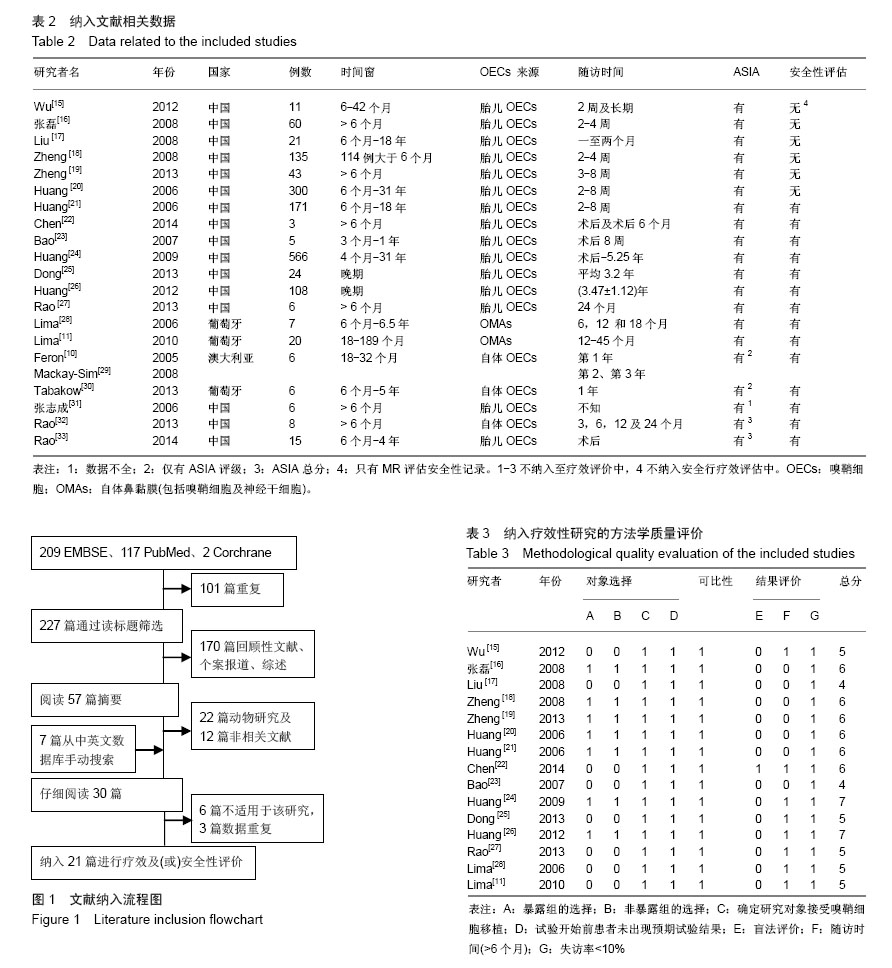
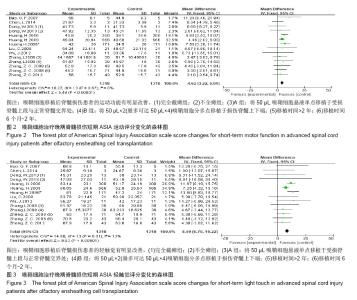
2.3 Meta分析结果 2.3.1 疗效性分析 (1)短期疗效结果:异质性检验显示移植术后,短期运动及轻触觉功能改变在各研究间具有同质性(运动评分I2=0%,P=0.67;轻触觉评分I2=13%,P=0.31),采用固定效应模型进行分析提示:脊髓损伤患者在嗅鞘细胞移植前后运动、轻触觉功能评分差异有显著性意义[WMD运动= 4.62,95% CI(3.22,6.01),P < 0.000 01;WMD轻触觉=8.49,95%CI(6.76,10.22),P < 0.000 01],见图2,3。说明嗅鞘细胞移植后脊髓损伤患者的运动、轻触觉均有明显改善。 针刺觉功能的亚组内各研究间具有中度异质性(I2= 52%,P=0.01),见图4A。根据Cochrane手册,该研究不能接受I2 ≥ 50%的异质性结果。 为确定短期针刺觉评分变化的异质性来源,对结果进行了敏感性分析:逐一删除单项研究结果再行Meta分析后发现,剔除Chen等[22]的研究后,异质性明显降低(I2=21%,P=0.23)。考虑该试验例数只有3例,明显小于其他研究,固将其剔除后采用固定效应模型进行分析:脊髓损伤患者在嗅鞘细胞移植前后针刺觉功能评分差异有显著性意义[WMD针刺觉=9.30,95%CI(7.58,11.02),P < 0.000 01],见图4B。说明嗅鞘细胞移植后脊髓损伤患者的针刺觉在短期内有明显改善。 对嗅鞘细胞治疗晚期脊髓损伤的短期运动、轻触觉及针刺觉Meta分析结果绘制漏斗图,可见散点均匀分布在无效线两侧,提示发表偏倚的可能性很低,见图5。 (2)长期疗效结果:异质性检验显示移植术后,长期运动、轻触觉、针刺觉功能改变在各研究间具有同质性(运动评分I2=0%,P=0.95;轻触觉评分I2=0%,P=0.76;针刺觉评分I2=0%,P=0.91),采用固定效应模型进行分析提示:脊髓损伤患者在嗅鞘细胞移植前后运动、轻触觉、针刺觉功能评分差异有显著性意义[WMD运动=3.53,95%CI (0.71,6.34),P=0.01;WMD轻触觉=8.34,95%CI(4.65,12.03),P < 0.000 01;WMD针刺觉=7.09,95%CI(3.27,10.91),P < 0.000 3],见图6。说明嗅鞘细胞移植后长期随访(≥1年)显示,脊髓损伤患者的运动、轻触觉及针刺觉均有明显改善。 对嗅鞘细胞治疗晚期脊髓损伤的长期运动、轻触觉及针刺觉Meta分析结果绘制漏斗图,可见散点均匀分布在无效线两侧,提示发表偏倚的可能性很低,见图7。"
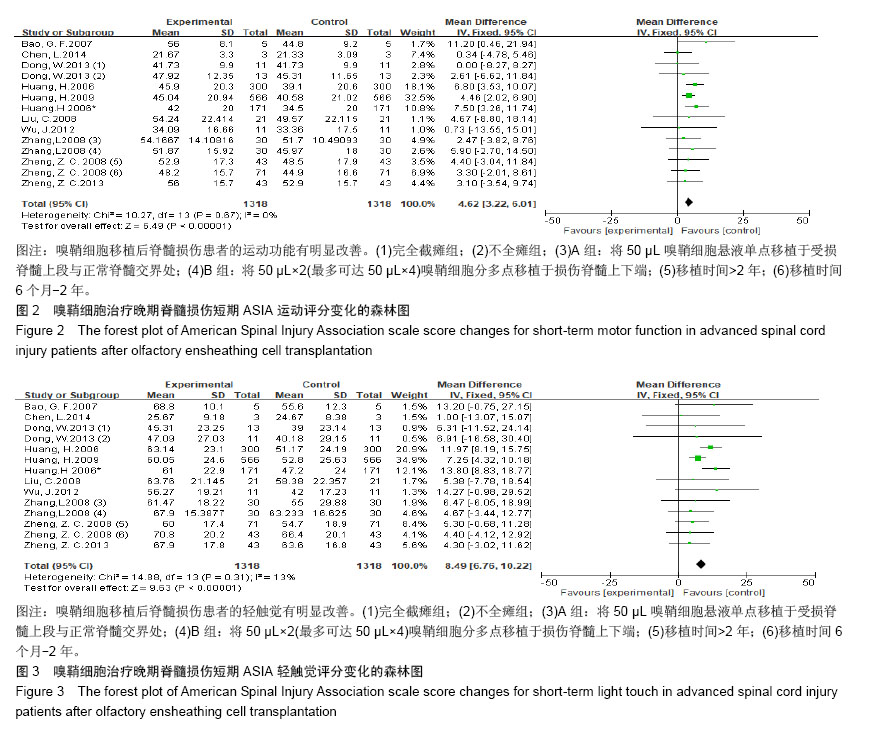
| [1] Holmes D. Repairing the neural highway. Nature. 2017;552(7684): S50-S51.[2] Barber PC, Lindsay RM. Schwann cells of the olfactory nerves contain glial fibrillary acidic protein and resemble astrocytes. Neuroscience. 1982;7(12):3077-3090.[3] Ranmón-Cueto A, Valverde F. Olfactory bulb ensheathing glia: a unique cell type with axonal growth-promoting properties. Glia. 1995; 14(3):163-173.[4] Doucette R. Glial influences on axonal growth in the primary olfactory system. Glia.2010;3(6):433-449.[5] 朱海涛,朱悦,孙德日. 嗅鞘细胞抑制脊髓损伤后硫酸软骨素蛋白聚糖表达的实验研究[J]. 中国医科大学学报, 2007, 36(3):244-246.[6] Doucette R. Glial cells in the nerve fiber layer of the main olfactory bulb of embryonic and adult mammals. Microsc Res Tech. 1993; 24(2):113-130.[7] Khankan RR, Griffis KG, Haggerty-Skeans JR, et al. Olfactory Ensheathing Cell Transplantation after a Complete Spinal Cord Transection Mediates Neuroprotective and Immunomodulatory Mechanisms to Facilitate Regeneration. J Neurosci. 2016;36(23): 6269-6286.[8] Pérez-Bouza A, Wigley CB, Nacimiento W, et al. Spontaneous orientation of transplanted olfactory glia influences axonal regeneration. Neuroreport.1998;9(13):2971-2975.[9] Ranmón-Cueto A, Cordero M I, Santosbenito F F, et al. Functional recovery of paraplegic rats and motor axon regeneration in their spinal cords by olfactory ensheathing glia. Neuron. 2000; 25(2): 425-435.[10] Féron F, Perry C, Cochrane J, et al.Autologous olfactory ensheathing cell transplantation in human spinal cord injury.Brain. 2005;128(Pt 12):2951-2960.[11] Lima C, Escada P, Pratas-Vital J,, et al. Olfactory mucosal autografts and rehabilitation for chronic traumatic spinal cord injury. Neurorehabil Neural Repair. 2010;24(1):10-22.[12] Li L, Adnan H, Xu B, et al. Effects of transplantation of olfactory ensheathing cells in chronic spinal cord injury: a systematic review and meta-analysis. Eur Spine J. 2015;24(5):919-930.[13] Huang H, Chen L, Wang H, et al.Influence of patients' age on functional recovery after transplantation of olfactory ensheathing cells into injured spinal cord injury.Chin Med J (Engl). 2003; 116(10): 1488-1491[14] Zheng Z, Liu C, Zhang L, et al. Olfactory ensheathing cell transplantation in 106 patients with old spinal cord injury Differences in ages, sexes, disease courses, injured types and sites. Neural Regen Res.2007;2(6):380-384.[15] Wu J, Sun T, Ye C, et al. Clinical observation of fetal olfactory ensheathing glia transplantation (OEGT) in patients with complete chronic spinal cord injury. Cell Transplantation. 2012;21 Suppl 1(1):S33-7.[16] 张磊,郑遵成,刘超,等.嗅鞘细胞移植部位与剂量的选择对陈旧性脊髓损伤患者60例神经恢复的影响[J].中国民康医学,2008, 20(9): 870-871.[17] 刘超,郑遵成,高瑞,等. 嗅鞘细胞移植术后脊髓损伤患者功能的评价[J]. 中国组织工程研究与临床康复, 2008,12(16):3037-3040.[18] 郑遵成,刘超,高瑞,等.移植时间对嗅鞘细胞移植治疗脊髓损伤效果的影响[J]. 中国组织工程研究与临床康复, 2008,12(3):583-586.[19] Zheng Z, Liu G, Chen Y, et al.Olfactory ensheathing cell transplantation improves sympathetic skin responses in chronic spinal cord injury.Neural Regen Res.2013;8(30):2849-2855.[20] 黄红云,王洪美,陈琳,等. 胚胎嗅鞘细胞移植治疗晚期脊髓损伤影响功能恢复的因素[J]. 中国修复重建外科杂志, 2006,20(4):434-438.[21] 黄红云,陈琳,王洪美,等.嗅鞘细胞移植改善晚期脊髓损伤患者神经功能的近期效应[J]. 中国临床康复,2006,10(13):190-192.[22] Chen L, Huang H, Xi H, et al. A prospective randomized double-blind clinical trial using a combination of olfactory ensheathing cells and Schwann cells for the treatment of chronic complete spinal cord injuries. Cell Transplantation. 2014;23 Suppl 1:S35.[23] 保国锋,崔志明,李卫东,等. 嗅鞘细胞移植治疗脊髓损伤5例报告[J].中国组织工程研究与临床康复,2007,11(3):512-514.[24] Huang H, Chen L, Xi H, et al. [Olfactory ensheathing cells transplantation for central nervous system diseases in 1,255 patients. Zhongguo Xiu Fu Chong Jian Wai Ke Za Zhi. 2009; 23(23):14-20.[25] Wang D, He X, Li H, et al. Five years follow-up observation on patients with spinal cord injury treated with olfactory ensheathing cell transplantation. J Investigative Med. 2013:S5-S6.[26] Huang H, Xi H, Chen L, et al. Long-term outcome of olfactory ensheathing cell therapy for patients with complete chronic spinal cord injury.Cell Transplantation.2012;21 Suppl 1(1):S23.[27] Rao Y, Zhu W, Guo Y, et al. Long-term outcome of olfactory ensheathing cell transplantation in six patients with chronic complete spinal cord injury. Cell Transplantation. 2013;22(1): S21-S25.[28] Lima C, Pratas-Vital J, Escada P, et al.Olfactory mucosa autografts in human spinal cord injury: a pilot clinical study.J Spinal Cord Med. 2006;29(3):191-203. [29] Mackay-Sim A, Féron F, Cochrane J, et al. Autologous olfactory ensheathing cell transplantation in human paraplegia: a 3-year clinical trial. Brain.2008;131(Pt 9): 2376-2386.[30] Tabakow P, Jarmundowicz W, Czapiga B, et al. Transplantation of autologous olfactory ensheathing cells in complete human spinal cord injury. Cell Transplantation.2013; 22(9):1591-1612.[31] 张志成,孙天胜,叶超群,等. 胸脊柱脊髓损伤的治疗[J]. 中国康复理论与实践, 2006, 12(4):336-338.[32] Rao Y, Zhu W, Liu H, et al. Clinical application of olfactory ensheathing cells in the treatment of spinal cord injury. J Int Med Res. 2013;41(2):473-481.[33] Rao YJ, Zhu WX, Du ZQ, et al. Effectiveness of olfactory ensheathing cell transplantation for treatment of spinal cord injury. Genet Mol Res. 2014;13(2):4124-4129.[34] Hagell P, Brundin P. Cell survival and clinical outcome following intrastriatal transplantation in Parkinson disease. J Neuropathol Exp Neurol. 2001;60(8):741-752.[35] Kordower JH, Styren S, Clarke M, et al. Fetal grafting for Parkinson's disease: expression of immune markers in two patients with functional fetal nigral implants. Cell Transplantation. 1997; 6(3):213.[36] Louveau A, Smirnov I, Keyes TJ, et al.Structural and functional features of central nervous system lymphatic vessels. Nature. 2015,523(7560):337-341[37] 陈琳,方明俊,黄红云,等.人胚胎嗅鞘细胞移植供、受者HLA配型方法介绍[J].中国医疗前沿,2009,4(22):20-20.[38] Xiao J, Chen L, Mao G, et al. Neurorestorative clinical application standards for the culture and quality control of olfactory ensheathing cells. J Neurorestoratol,2017; 5:175-179.[39] Nakhjavan-Shahraki B; Yousefifard M; Rahimi-Movaghar V, et al.Transplantation of olfactory ensheathing cells on functional recovery and neuropathic pain after spinal cord injury; systematic review and meta-analysis.Sci Rep.2018;8(1):325[40] Jiang Y, Zhu J, Xu G; et al.Intranasal delivery of stem cells to the brain.Expert Opin Drug Deliv.2011;8(5):623-32[41] Ninomiya K, Iwatsuki K, Ohnishi Y, et al.Intranasal delivery of bone marrow stromal cells to spinal cord lesions.J Neurosurg Spine.2015;23(1):111-119[42] Nijboer CH; Kooijman E, van Velthoven CT, et al. Intranasal Stem Cell Treatment as a Novel Therapy for Subarachnoid Hemorrhage. Stem Cells Dev.2018;27(5):313-325[43] Salama M, Sobh M, Emam M, et al.Effect of intranasal stem cell administration on the nigrostriatal system in a mouse model of Parkinson's disease. Exp Ther Med. 2017;13(3):976-982[44] Assinck P, Duncan GJ, Hilton BJ, et al.Cell transplantation therapy for spinal cord injury.Nat Neurosci. 2017;20(5):637-647. |
| [1] | Zhang Tongtong, Wang Zhonghua, Wen Jie, Song Yuxin, Liu Lin. Application of three-dimensional printing model in surgical resection and reconstruction of cervical tumor [J]. Chinese Journal of Tissue Engineering Research, 2021, 25(9): 1335-1339. |
| [2] | Zeng Yanhua, Hao Yanlei. In vitro culture and purification of Schwann cells: a systematic review [J]. Chinese Journal of Tissue Engineering Research, 2021, 25(7): 1135-1141. |
| [3] | Xu Dongzi, Zhang Ting, Ouyang Zhaolian. The global competitive situation of cardiac tissue engineering based on patent analysis [J]. Chinese Journal of Tissue Engineering Research, 2021, 25(5): 807-812. |
| [4] | Wu Zijian, Hu Zhaoduan, Xie Youqiong, Wang Feng, Li Jia, Li Bocun, Cai Guowei, Peng Rui. Three-dimensional printing technology and bone tissue engineering research: literature metrology and visual analysis of research hotspots [J]. Chinese Journal of Tissue Engineering Research, 2021, 25(4): 564-569. |
| [5] | Chang Wenliao, Zhao Jie, Sun Xiaoliang, Wang Kun, Wu Guofeng, Zhou Jian, Li Shuxiang, Sun Han. Material selection, theoretical design and biomimetic function of artificial periosteum [J]. Chinese Journal of Tissue Engineering Research, 2021, 25(4): 600-606. |
| [6] | Liu Fei, Cui Yutao, Liu He. Advantages and problems of local antibiotic delivery system in the treatment of osteomyelitis [J]. Chinese Journal of Tissue Engineering Research, 2021, 25(4): 614-620. |
| [7] | Li Xiaozhuang, Duan Hao, Wang Weizhou, Tang Zhihong, Wang Yanghao, He Fei. Application of bone tissue engineering materials in the treatment of bone defect diseases in vivo [J]. Chinese Journal of Tissue Engineering Research, 2021, 25(4): 626-631. |
| [8] | Zhang Zhenkun, Li Zhe, Li Ya, Wang Yingying, Wang Yaping, Zhou Xinkui, Ma Shanshan, Guan Fangxia. Application of alginate based hydrogels/dressings in wound healing: sustained, dynamic and sequential release [J]. Chinese Journal of Tissue Engineering Research, 2021, 25(4): 638-643. |
| [9] | Chen Jiana, Qiu Yanling, Nie Minhai, Liu Xuqian. Tissue engineering scaffolds in repairing oral and maxillofacial soft tissue defects [J]. Chinese Journal of Tissue Engineering Research, 2021, 25(4): 644-650. |
| [10] | Xing Hao, Zhang Yonghong, Wang Dong. Advantages and disadvantages of repairing large-segment bone defect [J]. Chinese Journal of Tissue Engineering Research, 2021, 25(3): 426-430. |
| [11] | Chen Siqi, Xian Debin, Xu Rongsheng, Qin Zhongjie, Zhang Lei, Xia Delin. Effects of bone marrow mesenchymal stem cells and human umbilical vein endothelial cells combined with hydroxyapatite-tricalcium phosphate scaffolds on early angiogenesis in skull defect repair in rats [J]. Chinese Journal of Tissue Engineering Research, 2021, 25(22): 3458-3465. |
| [12] | Wang Hao, Chen Mingxue, Li Junkang, Luo Xujiang, Peng Liqing, Li Huo, Huang Bo, Tian Guangzhao, Liu Shuyun, Sui Xiang, Huang Jingxiang, Guo Quanyi, Lu Xiaobo. Decellularized porcine skin matrix for tissue-engineered meniscus scaffold [J]. Chinese Journal of Tissue Engineering Research, 2021, 25(22): 3473-3478. |
| [13] | Mo Jianling, He Shaoru, Feng Bowen, Jian Minqiao, Zhang Xiaohui, Liu Caisheng, Liang Yijing, Liu Yumei, Chen Liang, Zhou Haiyu, Liu Yanhui. Forming prevascularized cell sheets and the expression of angiogenesis-related factors [J]. Chinese Journal of Tissue Engineering Research, 2021, 25(22): 3479-3486. |
| [14] | Liu Chang, Li Datong, Liu Yuan, Kong Lingbo, Guo Rui, Yang Lixue, Hao Dingjun, He Baorong. Poor efficacy after vertebral augmentation surgery of acute symptomatic thoracolumbar osteoporotic compression fracture: relationship with bone cement, bone mineral density, and adjacent fractures [J]. Chinese Journal of Tissue Engineering Research, 2021, 25(22): 3510-3516. |
| [15] | Liu Liyong, Zhou Lei. Research and development status and development trend of hydrogel in tissue engineering based on patent information [J]. Chinese Journal of Tissue Engineering Research, 2021, 25(22): 3527-3533. |
| Viewed | ||||||
|
Full text |
|
|||||
|
Abstract |
|
|||||
